Jamaica, along with their top –Champions League– star, Khadija Shaw, will face a huge challenge in the 2023 Women’s World Cup. However, the quality of their squad and the variety of their direct and vertical football, as well as being fast, especially through the flanks, may be the answer to battle for a good run in the tournament.
Lorne Donaldson’s team have one of the most difficult groups of the entire championship, facing France and Brazil, as well as newcomer Panama. With the good and fun style of play that they have shown, as well as being defensively organised, it will be interesting to see what they are going to do to neutralise their opponents.
This tactical analysis will give an explanation of their tactics and an analysis of what they approach in several phases of the game, in form of a scout report.
Predicted starting XI
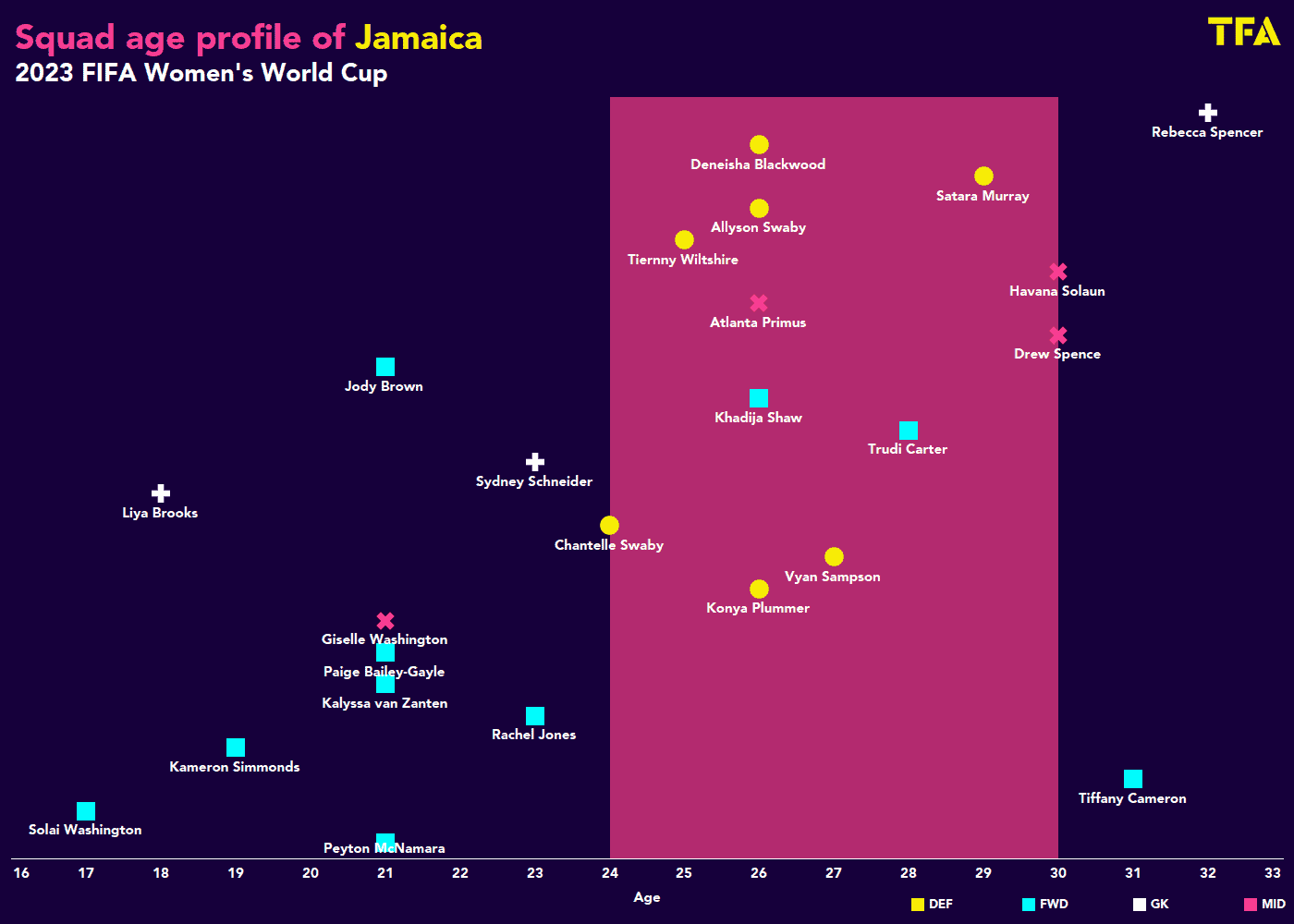
In a 4-3-3 that can vary between 4-4-2 or 4-2-3-1 as well, we expect the veteran Rebecca Spencer to start in goal. She shows confidence with her shot-stopping and long distribution. In the back four, Allyson Swaby and Satara Murray are the expected CBs in the starting XI.
Deneisha Blackwood and Tiernny Wiltshire would likely complete the spots for the back four on the wings, both with the possibility of playing on either flank, offering versatility.
We think their midfield three will be comprised of Havana Solaun as the lone ‘#6’, with Atlanta Primus and Drew Spence more advanced.
In attack, wingers Trudi Carter and Jody Brown will seek to offer verticality and aggressiveness alongside the team’s best player, one of the WSL best players, Manchester City’s Khadija Shaw.
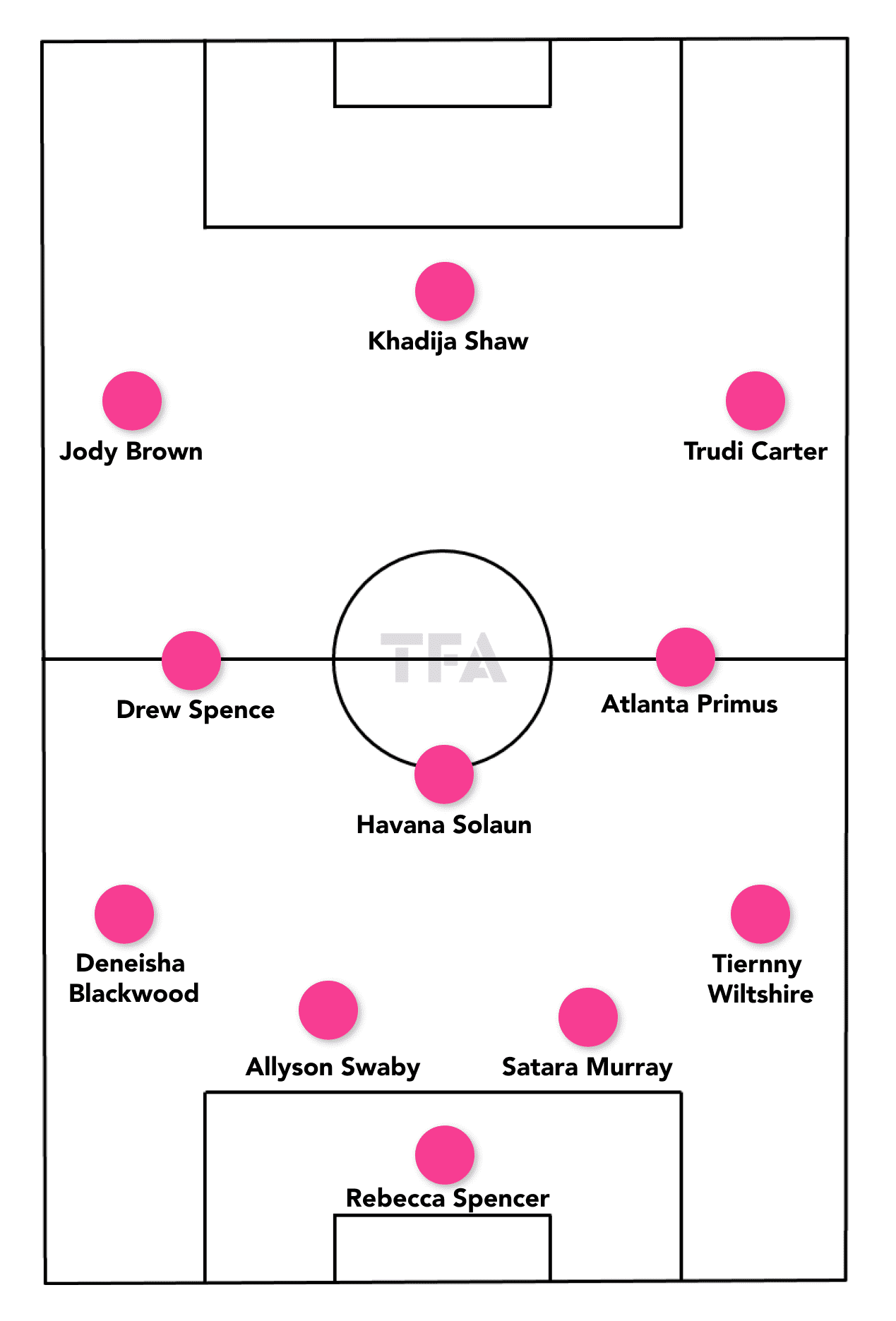
Attacking Phase
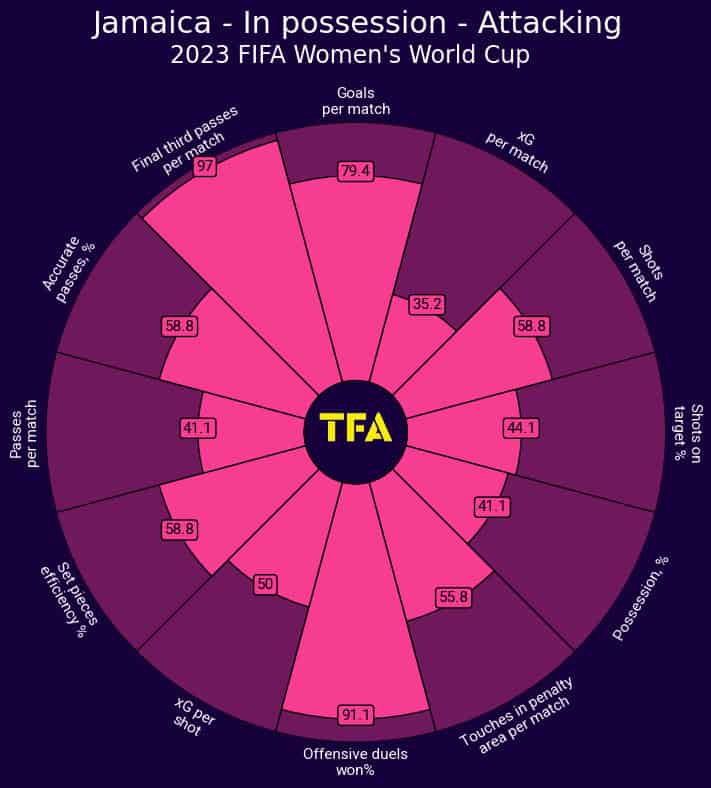
Jamaica look to generate plays with a faster tone, usually dynamising with one/two touches of the ball to elevate their team’s positioning on the pitch in a more agile manner. There are certain points of focus in different positions of the team, such as their FBs and wingers.
They act quickly and from memory. The first passages of the Jamaican team’s possessions are passes between the CBs and the defensive midfielder that is released at the base of the play, to later move the ball to the sides.
The back four stays low, looking to be close to constantly turning the ball over and thus continue looking for options with which to progress. The main idea is that the two FBs stay low to be able to switch the ball quickly towards them, which automatically look to execute passes towards the winger on their flank; depending on their body-positioning, the type of delivery will vary: Into space or to the foot.
In the image below, we can see how the winger received the pass making a body turn to evade the player on top of her. Much of the attacking ideas depend on the ideas of the wingers in Jamaica’s system.
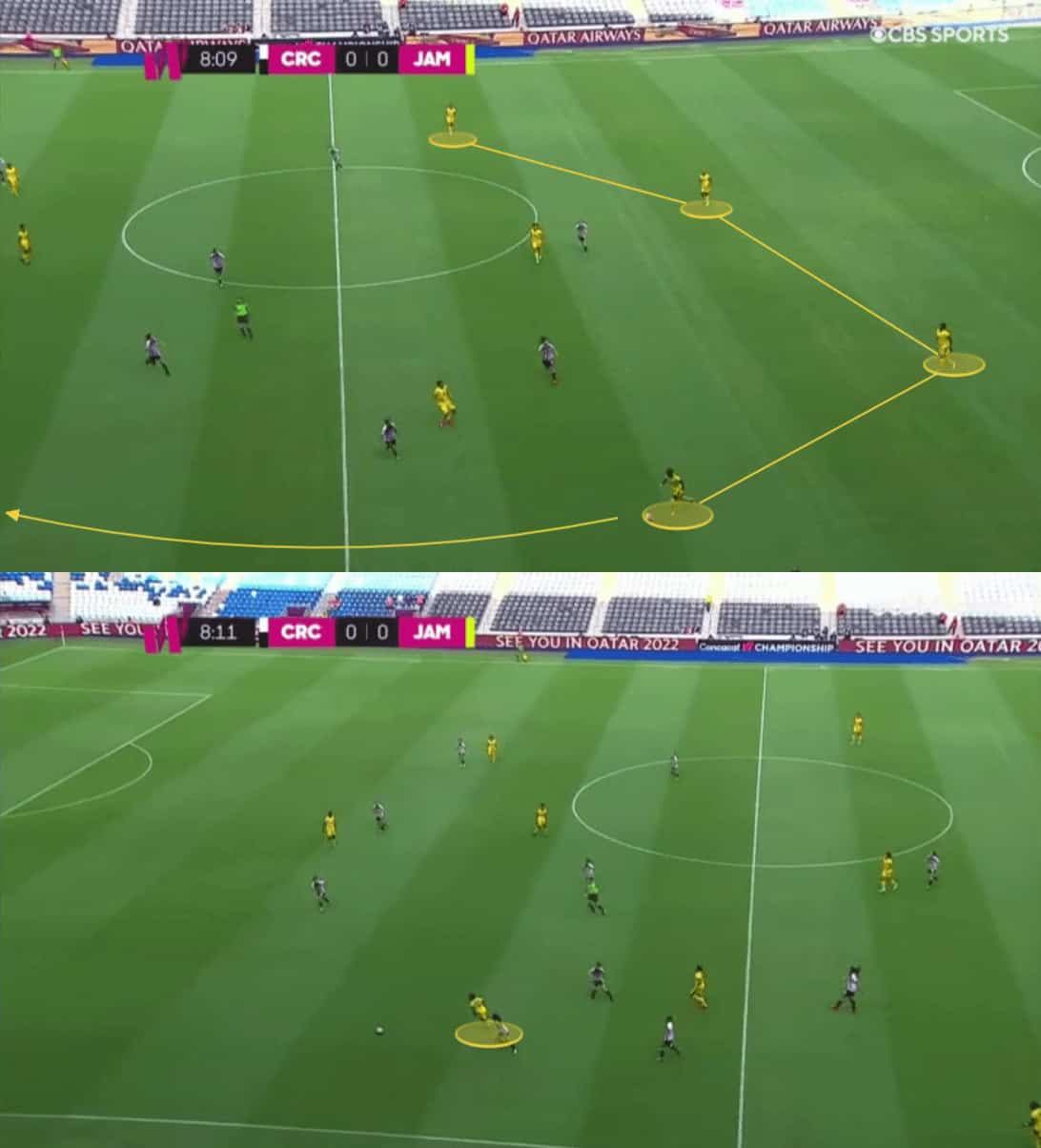
Wingers do not usually stay only in the wide channel. In fact, their mobility is dynamic so that the FBs can be more effective with these passes and not become predictable. They can perform dismarking moves from outside to inside or vice versa.
As we mentioned above, the executions vary between passes so that the winger can run in behind, as well as receive to feet and then demonstrate their offensive quality to create plays with dribbling/ball-carrying — an important point to analyse in the Reggae Girlz.

Lorne Donaldson has worked to give his players more freedom so that they create plays when they have no vision-angle, thanks to their ball-carrying or dribbling — not only allowing this to the most dangerous players, such as their forwards, including Trudi Carter, who is one of the ones who uses this resource the most in the team.
From the first line of the team’s possession, we can see how this principle has fit into the mentality of the players. The CBs are able to take the ball and look for a new passing option by activating empty spaces with their accelerations, as well as the FBs who take an important role here, going outside or inside to later send long passes to wingers or the CF.
The midfielders with a different role, serve as support for these players who are looking to drive the ball through the lines. While they are more aggressive and proactive in their ideals, the midfielders are the axis to be an option for releasing the ball and then they return it, generating quick one-twos to touch the ball and rapidly reach the rival’s penalty area.
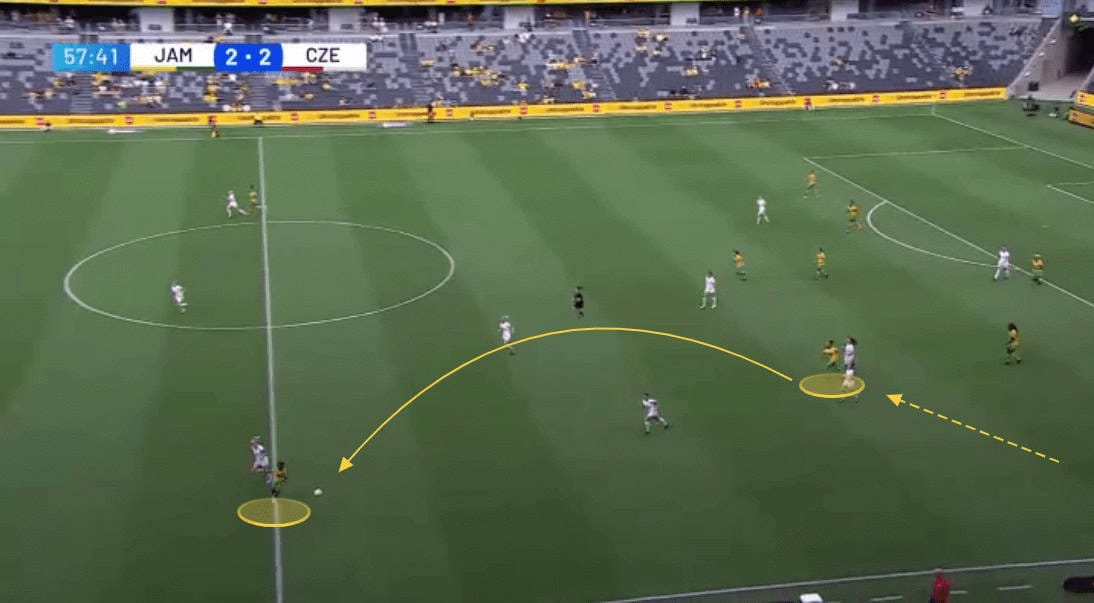
Quick plays are the hallmark of Jamaica within their style of play. Several movements are made to provide fluidity in the progression of this form when they have the ball. Attracting players from different positions to get into triangulations or 1-2s to then send passes into space.
Khadija Shaw begins to show her importance in the team with her touches, generating spaces that other teammates take and she offers technique in her solid link-up to advance.
However, it’s not just her. The basis of these quick plays is that one of the midfielders approaches, as well as a winger/CF together with another midfielder or in case this is an isolated sequence in the wing, the FB of said side joins, which normally starts this with their progressive runs.
The idea behind this is to not restart possessions when this happens. The main thing to do after these quick touches is free a teammate that can carry the ball forward or penetrate threatening areas for the opponent.
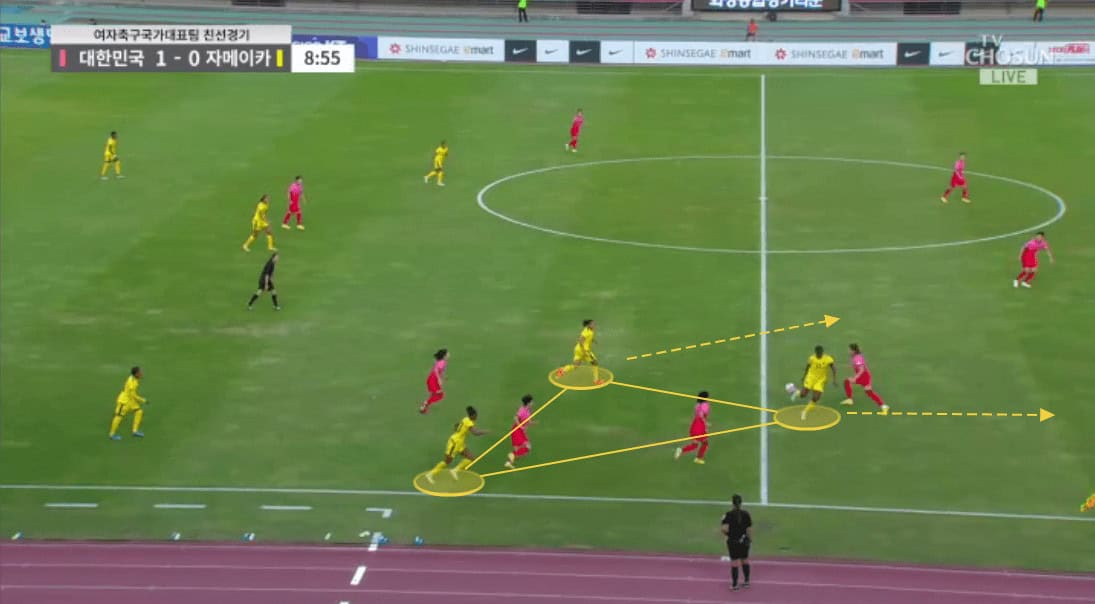
Khadija Shaw’s dropping from her line is something that provides a lot of progression for her team, as this has been a movement very well-worked out to the players on how and when to take these spaces she frees to be activated into space.
The Manchester City player seeks to drag the opponent’s marking so that another teammate can make the right move and the ball carrier can send them a long ball in behind.
In the image below us, we find a play in which several principles coexist at the same time: It starts with a carry from the FB which releases the ball aggressively for the CF that drops into the half-space and with her first touch, she plays it to the midfielder who activates the player taking the space that Shaw generated with a pass in-behind.
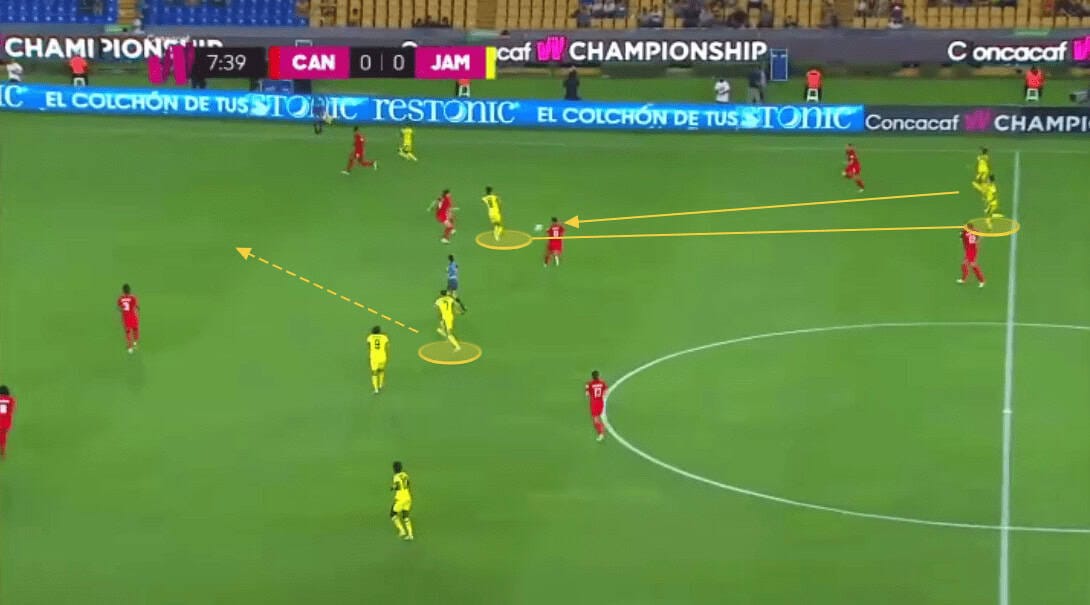
Last but not least, Jamaica have a key focus on second balls, bringing several players closer when a long ball from the opponent or their own teammates is executed.
These approaches from different players allow them to find closer passing lanes to later launch an in-behind pass, uncoordinating the rival block with the number of players overloading in one place and then releasing it quickly.
This is why they look to play several long passes at times. Besides times at which they couldn’t control the ball, the key thing is to have closer players to fight for it and gain an attacking situation out of nothing.
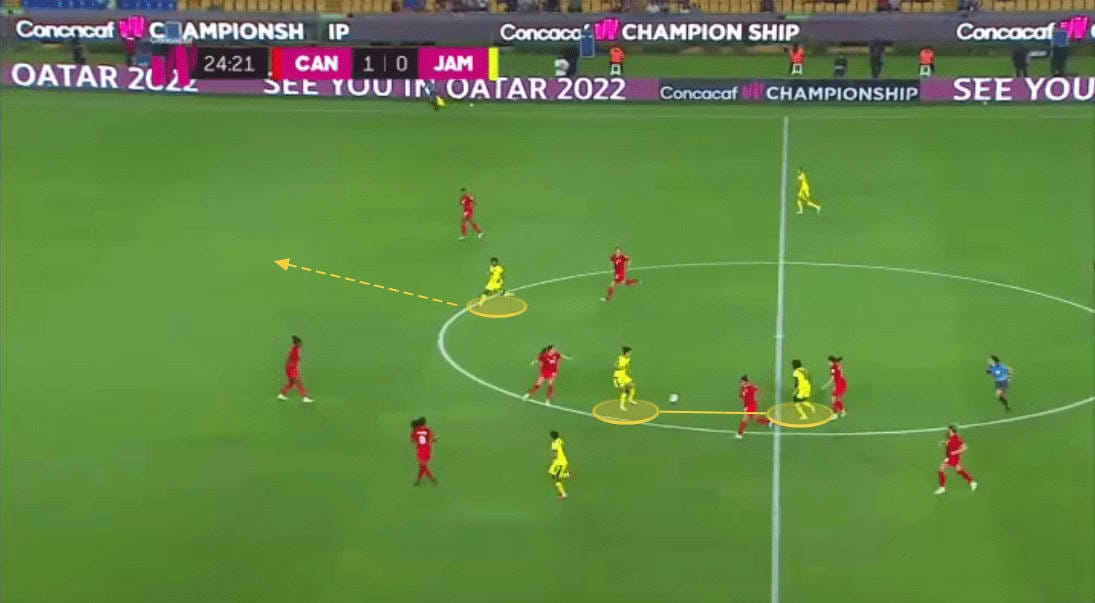
Jamaica are a fast team, both with their passes and when they take the ball and make runs with it, being aggressive in dribbling and finding teammates running at the back of defenders. They must improve their effectiveness in front of the goal, to be even more threatening than they already are.
Defensive Phase

Jamaica uses a zonal defensive system. In a mid-block, where they look to establish their closed lines with both wingers narrow and near the midfield line, they seek to force the opponent to progress towards the wings, this being the trap where the Jamaican players suffocate aggressively to steal.
Normally, there are two variations on their defensive model, closing with four players and two forwards on the front line who do not put pressure on the rival build-up, but look to cover the passing lane with the rival midfielder.
The second is with the forward alone and five players behind, looking to further compact the middle third where the rivals cannot receive, covering the central channel and the wide ones with more players.
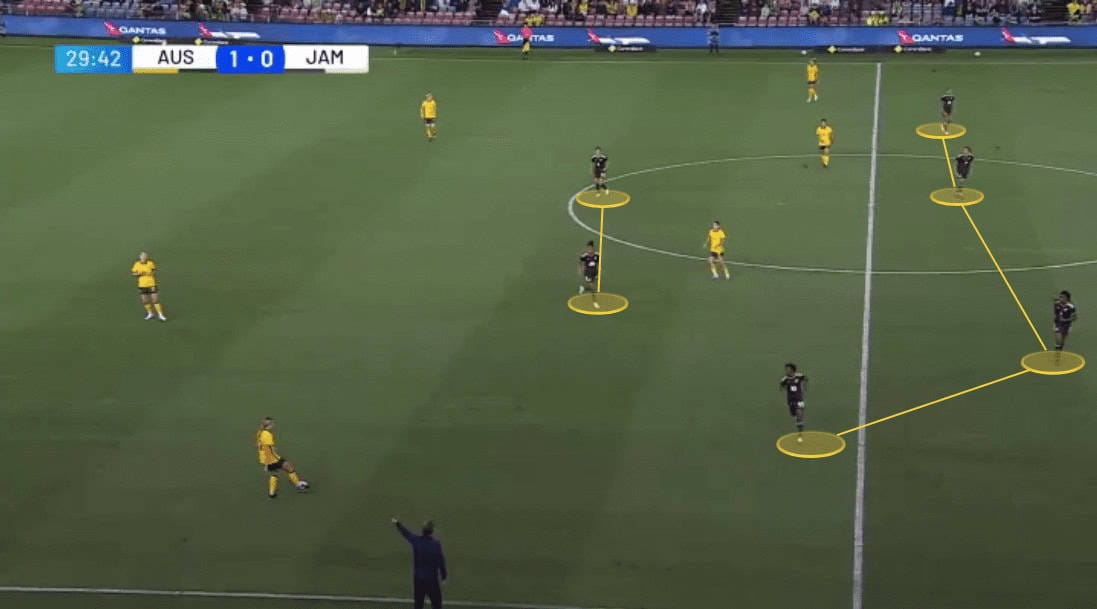
On some occasions, Jamaica look for one of their wingers to jump off the line to put pressure on the rival CB. This with an idea behind it: Force the long ball, which we already saw that they have managed how to win it and later get results to progress.
In the image below, we can see an example of how they do this — especially strong in this case against a right-footed LCB who couldn’t move to the left side due to the pressure and forced a long pass that they quickly recovered.
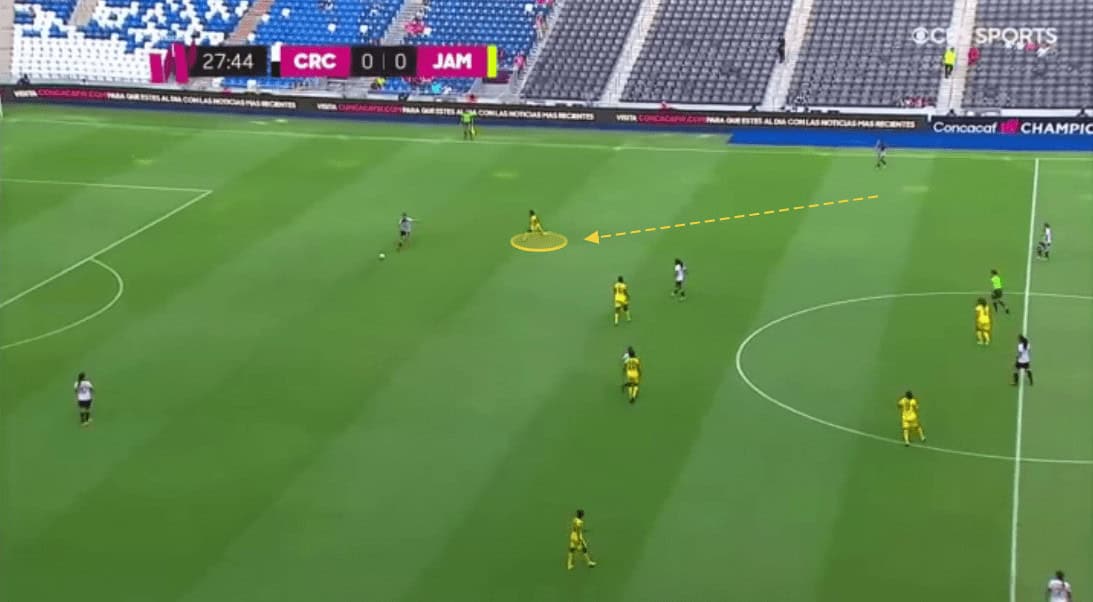
However, the main focus to recovering the ball when the rival is building is primarily mental: Patience. The mid-block swings from side to side, waiting for the right moment to stifle the opponent when they cross the line not allowed by them.
Normally it’s the middle third when an opponent receives between the lines or on the wings, where the coverage exchanges are quick between them: One jumps to the opponent, another covers the space and the FB seeks to press aggressively to steal and thus take the ball to carry it forward.
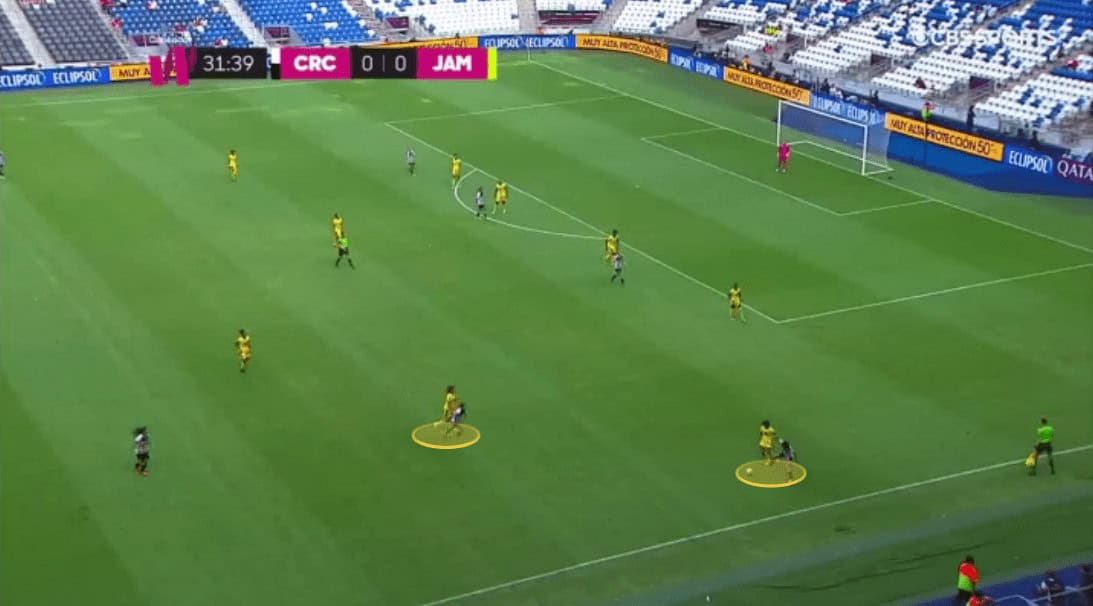
Transitions
Just as in the offensive phase, in which their ideas are fast and vertical touching the ball, in transitions it is usually similar.
However, there’s one of those principles that they do not look for so regularly in counterattacks. They prioritise receiving, turning and finding a teammate in a better position by releasing the pass quickly into space over the ball-carrying.
The task in this situation is to find the free player, especially in the central channel, so that he, with a vision of several options to execute the pass, makes the best decision without driving the ball so many meters to choose which player to find in a better position.
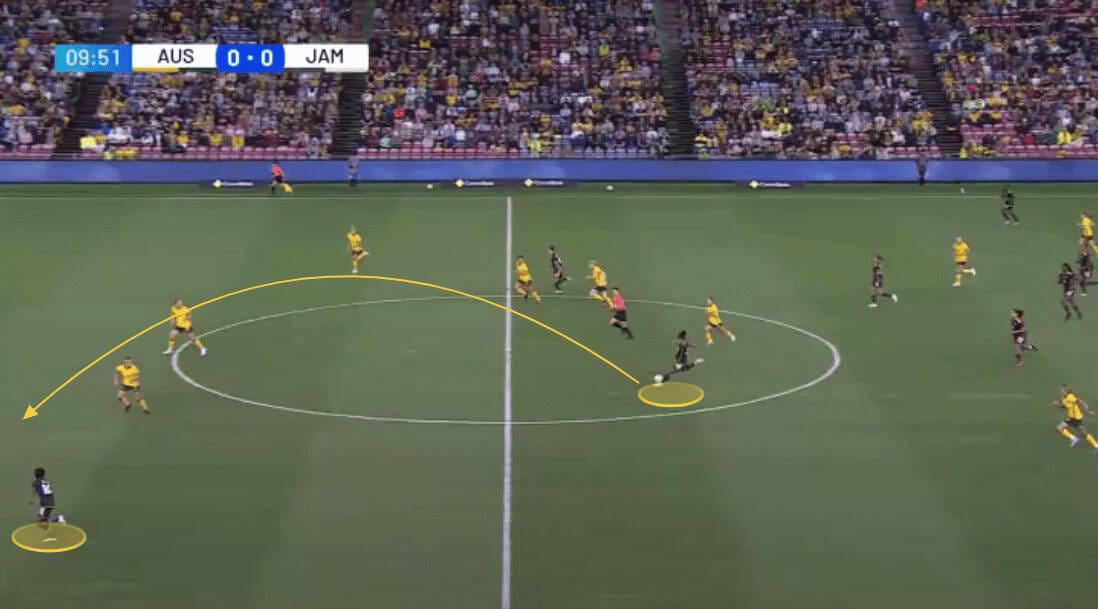
In defensive transitions, Jamaica look to be an aggressive team with a lot of commitment to their midfielders for trackbacks. Their back four, which is limited to taking height in the field when attacking, is usually compact and in line to wait for the opponent’s counterattack.
On the other hand, they show great proactivity in their actions, with a player always stifling the opponent, primarily a midfielder so that the back-four stays coordinated. One of the FBs or even CBs usually comes out to intercept the play if she covers a significant distance.
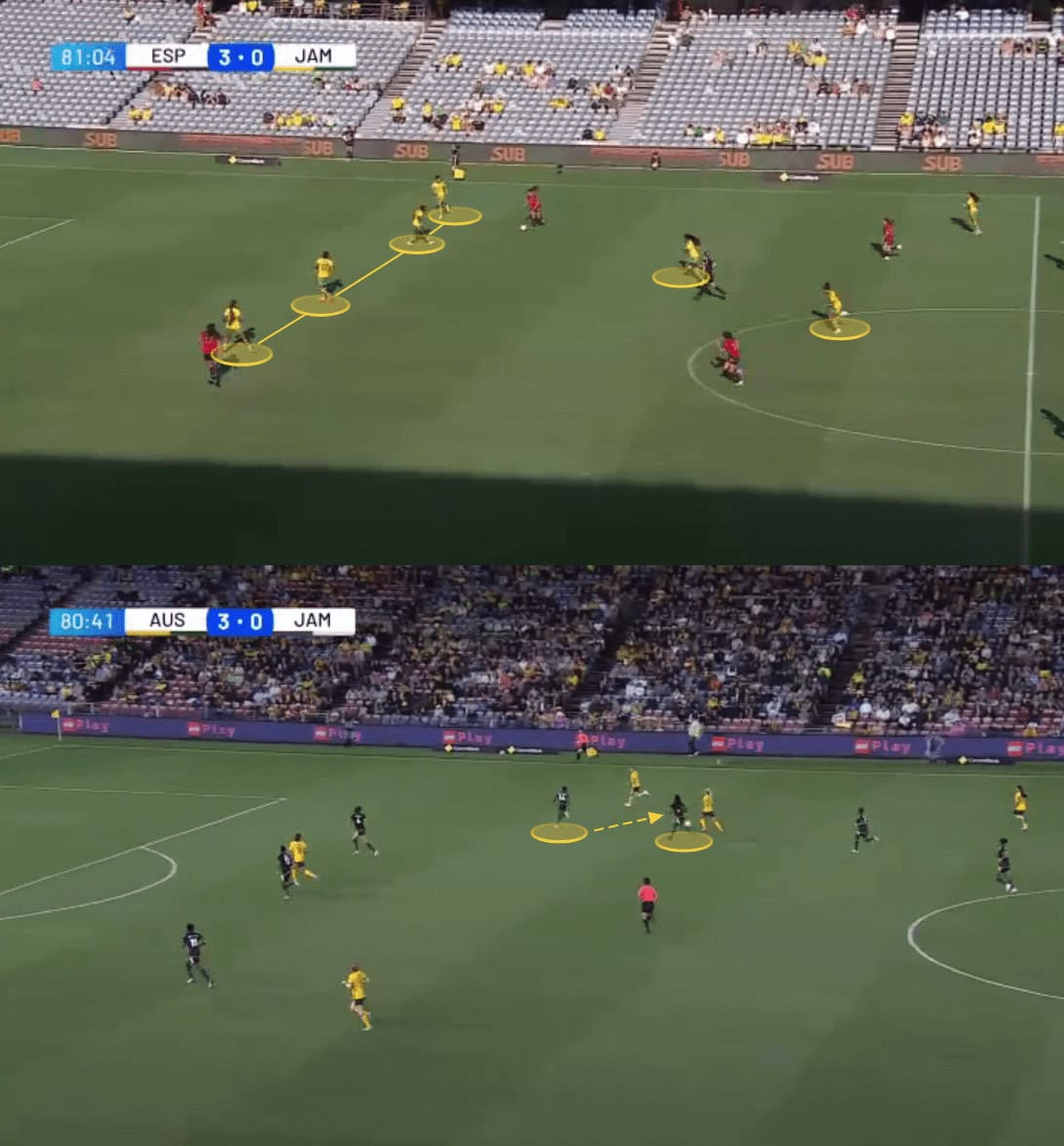
Defenders
Jamaica have quite an interesting and quality starting back-four when the names of Deneisha Blackwood, Satara Murray, Allyson Swaby and Tiernny Wiltshire are mentioned, wielding a combination of experience plus freshness between them.
Chantelle Swaby, Vyan Sampson and Konya Plummer are other options to rotate on defence.
Midfielders
Havana Solaun Atlanta Primus and Drew Spence, as we mentioned before, have all the qualities to be in the starting lineup as the midfield three. However, Giselle Washington is another natural midfielder that can contribute from the bench.
Forwards
We arrive at the part where Jamaica called up the most players and have the most quality with Khadija Shaw leading up front — and Trudi Carter and Jody Brown as the most possible wingers set to start in the tournament.
Nevertheless, names like Paige Bailey-Gayle, Kalyssa van Zanten, Rachel Jones, Kameron Simmonds, Tiffany Cameron, Solai Washington and Peyton McNamara are set to produce from the bench, with an official announcement soon about who will definitely be in the squad.
Key Player
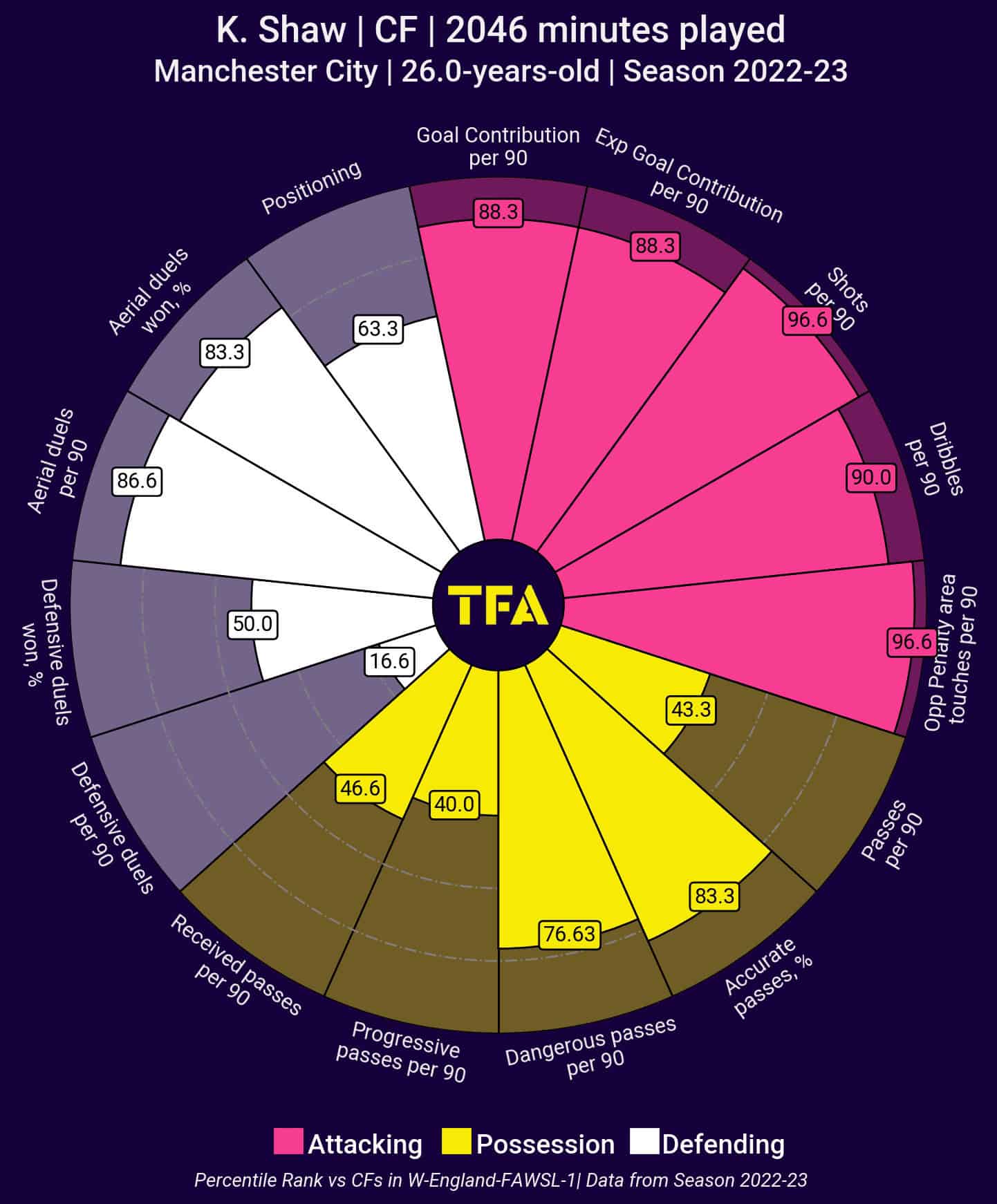
Of course, we’ve gone with the Manchester City goalscorer, Khadija Shaw, as our key player. She’s one of the best strikers and players in the world, who’s going to be leading the line and her squad in one of the most vital tournaments of her career.
And the tournament has arrived while she’s in the best form of her career. Her 31 goals in 30 matches of the WSL just tell the world that she’s ready for the big challenge with her national team where she’s also been scoring for fun of late.
Tournament Prediction
Jamaica don’t have an easy task on the surface. Indeed, they share a group with Panama, a new team in the tournament, but France and Brazil are also present making progression far from a simple task. Two of the best teams in the world will look for a place in the next round. However, Jamaica will not fight and they’re totally capable of getting into the knockout stages with their fast, explosive and dynamic team, which has a lot of quality in terms of names and technique on the pitch.
It would be a difficult first path, but they have shown a threatening game style that can bring them matches to remember in this competition, trying to get out of the group stages for the first time.

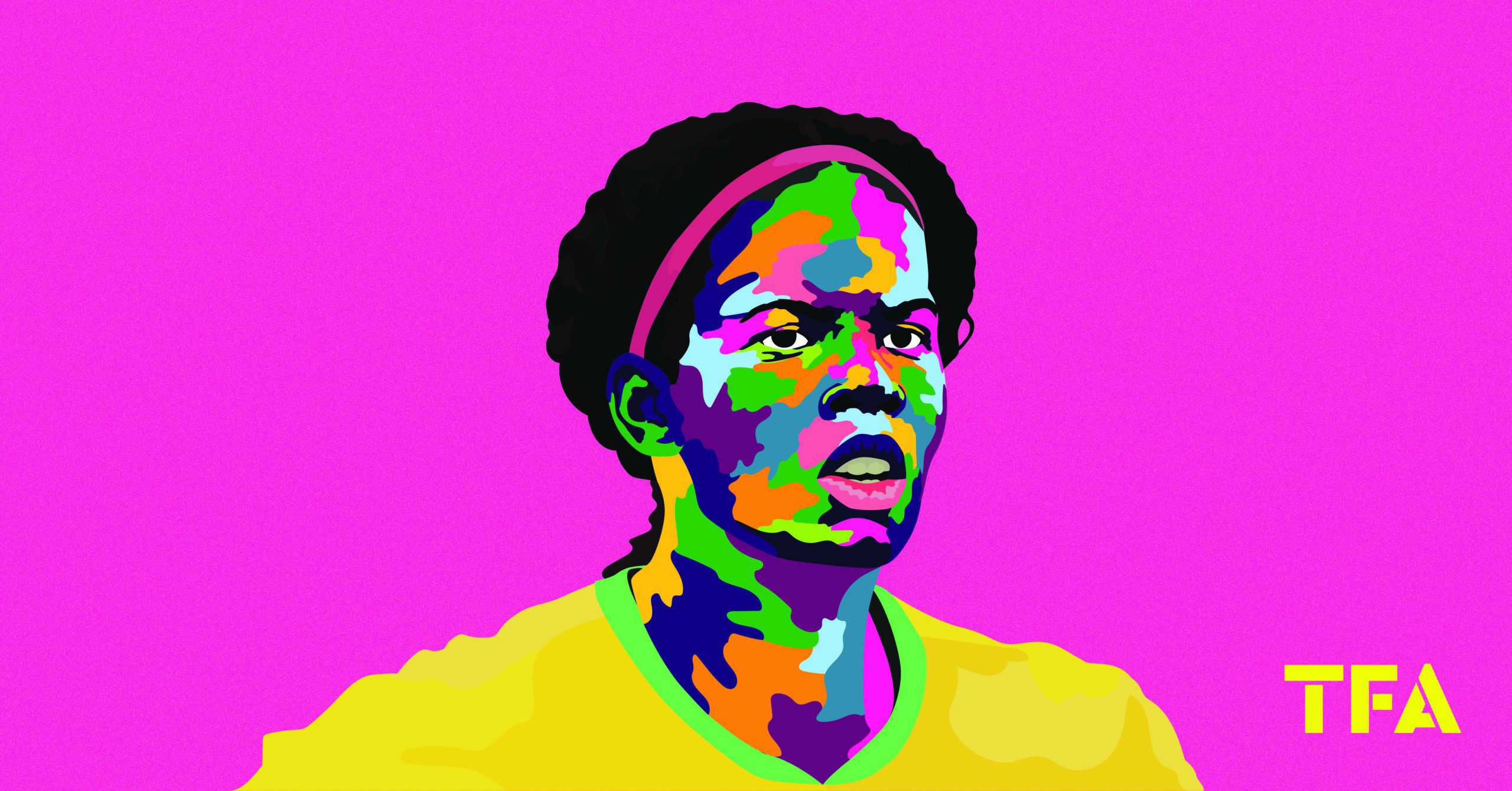




Comments